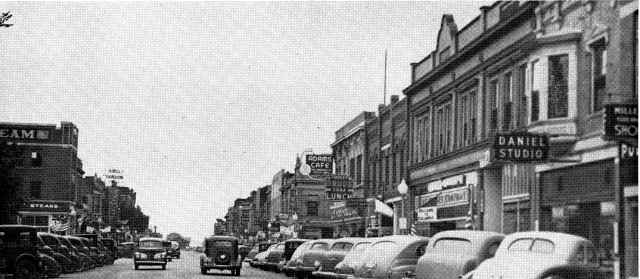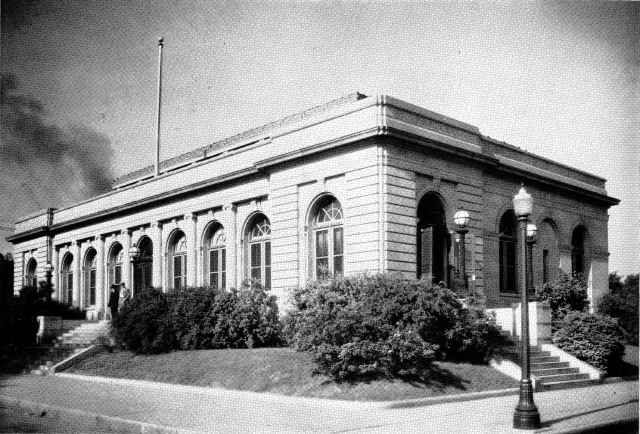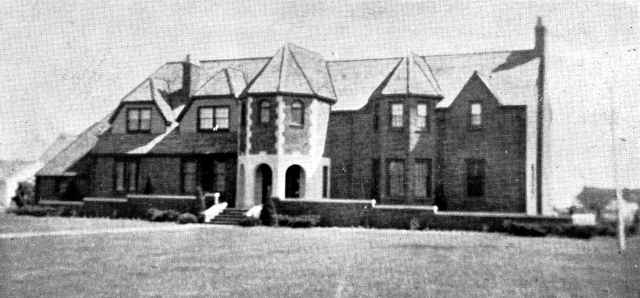
NEGenWeb Project
Resource Center
On-Line Library
| Contemporary | 565 |

Thirteenth Street, looking east from Twenty-seventh Avenue
E. J. Jelden and Groeteke & Weinman, Doctors of Veterinary Medicine, serve the agricultural community, whose investment in farm animals is sizable. Supplies of a veterinarian nature are carried by the Blue Cross Serum Company, located in Columbus.
Regardless of the age or stage of development, every community must have a network of merchants, whose sales directly reflect the well-being of the people and the character of the entire group. In the days of the Romans, these merchants operated open-air market places. Later, there developed a ruling mercantile class. In America today, their profit provides the keynote to the economy of the twentieth century. Their philosophy prevails and it is the merchants and industrialists of our society who hold some of the highest positions in the community. They serve the people and the goods which they provide are the items which men need to survive.
In Columbus we have: Curry Brothers, Bordys' Store and Levine Brothers, exclusive dealers in men's clothing. Coal is sold by Columbus Fuel & Storage Company, Heynen Lumber Company, Mead Lumber Company and Viergutz Lumber & Coal Company.
The Telegram Package Delivery Service, which serves the surrounding towns, is located in Columbus. The following chain stores are located there also: Montgomery Ward & Company, J. C. Penney Company and Sears Roebuck & Company. These syndicate operations, a direct outgrowth of the concentration of business which has resulted in recent years, are complemented by a local retail chain organization, George Schweser's & Sons.
Food is a vital need of any community and although Columbus is located in the heart of a rich, productive agricultural district, she must depend upon many outside sources for routine needs such as meat, vegetables and other supplies.
The following grocers maintain establishments in Columbus: Angell Grocery, Baker's Store, Bud's Grocery, Columbus Meat Market, Council Oak Store, Ernst Grocery & Meat Market, Farmers Union Co-op Store, Greiner's Market and Gutzmer Grocery Company, the oldest in the community, Handy Grocery, Hinky-Dinky Store (a modern chain outlet), Ideal Grocery & Meat Market, J. R. Luschen Market, Pawnee Grocery & Meat Market, Robinson's Public Market*, Sweenie's Grocery, the West End Grocery, the Lone Star Store and Novicki Grocery in Duncan. The Nash-Dietz Company sells wholesale groceries to Platte County retailers and distributors. The Kaplan fruit market handles fresh fruit.
Harding's Sealtest Ice Cream is another mercantile operation in Columbus, revealing the age of specialization in its product which, a few years ago, was largely home-made.
Junk is handled by the Kavich Iron & Metal Company.
Liquor is sold by Fricke-Fleischer, Miessler Drug Company, and other liquor stores located in Columbus, while meat has four retail outlets
* Also known as the C. B. Speice Market.
| 566 | The History of Platte County Nebraska |

Columbus Post Office
in the county seat; the Columbus Meat Market, Greiner's Market, Teich Market and the West End Grocery.
Ready-to-wear, a field which has been enlarged by the innovation of mass production techniques, making it unnecessary for women to sew and design their own wearing apparel, supports these shops in Columbus: the Blue Bird, the Irene Shop, Joseph's, Levine Brothers and Marjorie's Smart Shop.
Music, for cultural and commercial purposes, is available in sheet, record or radio form at the Columbus Music Company, while the Miessler Book Store supplies news, periodicals and books to the Platte County population.
Shoes, another item of modern wearing apparel, are not obtainable at the cobbler's, but instead at the retail shoe store, an outlet of factories supplying hundreds of thousands of standardized boots and shoes. In Columbus Buck's Booterie, Woodrick and Allen, and the Polly Shoe Store sell retail footwear. Felix Fix, G. J. Schilz and Politis and Prokupek, repair shoes of all types.
Wholesale tobacco is handled in Columbus by R. D. Braithwaite Company, Cut-Rate Liquors and M. Venger & Sons, while variety stores include, Scott, Woolworth's, and Gerber's, at Duncan.
Industrial and manufacturing activities in Columbus are increasing constantly. A contemporary survey of the community reveals the Columbus Brewing Company, Nash-Dietz Company and the Worth Distributing Company. Bottlers include Canada Dry Distributors, Coca Cola Bottling Company, Dr. Pepper Bottling Company, Squirt Bottling Company, the Harding Company and the Seven-Up Bottling Company.
Fleischer-Schmid maintains a warehouse at Twenty-first Street and Fifteenth Avenue in Columbus; the Short Manufacturing Company produces dress shirts; and the Reece Wooden Sole Shoe Factory has been an outstanding industrial leader in the county for many years.
The field of entertainment is represented by the following local operations which attract customers from Columbus and the adjoining vicinity: The Columbus and the Swan Theatres;
| Contemporary | 567 |

Home of Otto F. Walter, 105 Pershing Road.
Bill's Recreation; Rex Club Rooms; Blake's Bowling Alleys. The following clubs and associations maintain permanent facilities in the town: American Legion, Eagles Home, Elks Club, Knights of Columbus, Veterans of Foreign Wars, Wayside Country Club and the Y.M.C.A.
Columbus, supported and reinforced by this high degree of commercial development, has always been proud of its correspondingly high ratio of home ownership. The pioneer spirit has not died out in this section of Nebraska, for many veterans of World War II, prevented by restrictions and limited in finances, built first the basements of their future homes, using this as living quarters until construction could be finished. Home building leads in the number of permits issued in Columbus with business establishments and garages a close second. Home remodeling is also on the increase.
The chain store movement is more noticeable in communities the size of Columbus. The opening of a Montgomery Ward Farm Store and large new warehouse, and the Sears and Roebuck Farm Store, clearly shows the optimistic outlook for the Platte County seat. New equipment moves into the city; the quiet and peace of early arbors vanish to make room for parking space and additional facilities. The tempo quickens. The town moves ahead.
Should the little group of thirteen founders enter Columbus today, they might issue a bulletin somewhat like this:
"After a most stimulating journey by iron horse, we did enter upon a community of twelve thousand persons, known as Columbus, Nebraska. This town, located as it is in the plains country, presents a friendly and prosperous spectacle and enjoys the reputation of an excellent trading center.
"The town did seem to be a virtual beehive of activity what with the daily arrival of countless conveyances and the passage of numerous horseless carriages traveling at a truly terrifying speed. Mail and supplies virtually pour into the community and a constant contact is maintained between the county seat and adjacent settlements to the east and west.
"It is deemed unwise to open a competitive publication in the town for all leisurely means of communication seem to have vanished and the most accurate reports reveal that the newspaper circulates to a total of six thousand souls and prints news which has been dispatched from all corners of the globe within a matter of hours. (Some even say minutes, but this is, of course, an exaggeration!)
"Instead of cattle, a substance known as natural gas is being sent into the territory from the state of Texas and power seems to be derived from a strange hydro affair located nearby on the Loup River.
"The city does indeed maintain a fine, impressive air but it is unlikely that further colonizing is necessary, this effort being carried out ably by the present citizens of the town. We found the sentiment of the community to be best expressed by the following motto, which is adopted and believed in by all:
"'Columbus --- a Good Place in Which to Live and Do Business.'"
| 568 | The History of Platte County Nebraska |
Paul Brandt Roen, M.D. |
"The men and women who settled our county - Yankees, Southern, Irish, German, Poles, Scandinavian, or Bohemian, were of the enterprising stock which has pioneered and made America what it is -- a leading nation of the world. The farmers, the business men and the professional men were of the highest type. These men were attracted to the rolling plains, not for the get-rich-quick reasons of men of many new settlements, but for the purpose of establishing homes and building a new progressive community.
They brought with them the culture of older countries from which they came and in a short space of a few decades -- a very few decades -- they transformed a rolling prairie that had been inhabited only by the buffalo and the Indian into a peaceful, modern community. There was an amalgamation of peoples, widely different, with the result that the second generation was renewed and invigorated by the diverse influence of this new land.
Among the lawyers of Platte County, there were none better for honest and sound legal advice than Judge A. M. Post who in defending the then privately owned Nebraska Water and Power Company before Governor A. C. Shallenberger, bested the New York lawyers in the opinion of H. E. Babcock, the president of the company and an able lawyer himself.
In my possession is a metal ash tray, the only remuneration received by Judge James G. Reeder for defending an itinerant gypsy woman charged with the murder of her own child. Colonel Michael Whitmoyer and W. A. McAllister were Civil War veterans. John J. Sullivan and John M. MacFarland made names for themselves in Omaha. Judge W. N. Hensley was renowned also for his skill with the
fishing rod.
Among the early bankers there were conservative business men like Leander Gerrard, George Hulst, A. Anderson, M. Brugger -- my father, O. T. Roen, who became prematurely gray trying to save the farmers in the panic of '93 and '94.
The Oehlrichs, Herman and Arnold, Jacob Griesen, J. H. Galley, the Grays, S. C., Clinton, and Arthur, and Theodore Friedhof were successful merchants. G. A. Schroeder had a mill and grain elevator as did Peter Becker.
In the medical profession, the neat scar on the right side of my head attests to the surgical skill of Doctor C. D. Evans, Sr. Hanging around the house that had been converted into the offices of Doctors Martyn, Evans, Geer, and Hansen gave me an opportunity to observe what, in this present day of clinical, x-ray and laboratorian would be a very high quality of medical practice. Many an accurate diagnosis was made by Doctor D. T. Martyn, Sr., as the patient stepped into the office. They and their confreres knew by clinical intuition what we call today psychosomatic medicine. They knew, better than now, the value of professional attire -- the Prince Albert coat and the high hat. In the home of my uncle, Doctor D. T. Martyn, for many years was a plug hat with a bullet hole through it shot off his head by a playful cowboy driving up a herd of Texas longhorns to ship on the Union Pacific Railroad at Columbus.
Long, dangerous drives into the country wrapped in buffalo robes with a lantern to light the way and to keep their feet from freezing in zero weather was a commonplace for these men.
Edgar Howard is a man who fitted his time neatly and appropriately. It was a time of eloquence and dignity, of honest sentiment and grandiose plans. The fact that visitors to his home* still come away valuing the bits of philosophy, the friendly, sage advice which he has accumulated in almost one century of life's experience ... proves that he has grown along with his community and his people. Always the raconteur, Edgar Howard's creed is as simple as this:
'The world has been good to me. I try to be grateful. I think I have in my mode of living. I hate no man.'
In writing about his beloved Nebraska, as well as in representing it in Congressional Chambers, Howard has never attempted to play down the vigorous pioneer-bred strains which made Platte County a dynamic locale. He is a man who has killed coyotes on the run. He understands the art of poker. And he knows Indians, not as an ethnic group-classified and analyzed, but as flesh-and-blood friends of the prairie.
From that long ago day, May 29, 1856, when the thirteen men arrived at the confluence of the Loup and Platte Rivers to found the town of Columbus, Nebraska, up through the years these were the men who, with the help of their wives, endured the hardships of blizzards, cyclones, floods, quicksand, crippling droughts, plagues of grasshoppers and the fear of marauding Indians. In spite of their travail, they wrested from the soil the sustenance of life; then they built churches, roads, bridges, schools and libraries. They nurtured and educated their children to be leaders of men, both in the nation and abroad. Their stamina and perseverance brought forth mansions from the rolling prairies and put tractors in the fields. These same men in larger communities, with more opportunity, would have made a nationwide name for themselves. As it is, they live secure in the memories and loving hearts of those who followed both family and friends."
*In 1950.
| Contemporary | 569 |
Inevitably, Edgar Howard stands out in this book because he stood out similarly in the life of Platte County In assembling and compiling the information for this history-the life of a century of people who have woven the threads of our being-Mr. Howard has appeared as a symbol, the bearer of a proud legend, as a man whose very simplicity in accomplishment makes him an eloquent figure.
And, in all truthfulness, his eloquence radiates from our own communal eloquence . . . the stories of men and women whose activities rarely intrigued the press, they were never reported in those momentous chronicles which exist on sensation, on a feverish, frenetic search for news that is bold and dramatic. But all drama is not that abrupt
These men and women of Platte County had and have yet the grandeur which starts on Monday and continues throughout the week. Theirs was a play which knew no startling climax, no sudden denouement. Rather, they learned to live in the tradition of their past . . . fighting depression and complexity, discrimination and disease even as their pioneer forebears fought Indians and drought ... the thousand odd vagaries of Nature.
To build a community slowly and gradually, bringing education and commerce into a wilderness requires more stamina and courage in many ways than a single brave and dangerous act. For the people of Columbus and Platte County have remained, for the most part, unknown and unknighted. They have watched and waited, working all the while, as not only their own nation but the world heard the stories of adventure in Alaskan wilds, of Colorado mining camps and logging towns in the Pacific Northwest. Lacking the older sophistication of the East, they somehow never earned the lusty reputation of the real West ... illuminated as it was with the romance of Spanish land grants, boom towns and quakes.
Edgar Howard |
But Nebraska ... Platte County ... Columbus had its genuine drama as this book should finally prove. Touched upon by the early explorers, it came to life again in the colorful era of the American Indian ... only to undergo a metamorphosis under the calloused hands of the pioneers. Why, then, should we not recognize and acknowledge the dramatic history of our community and proclaim it to the world? Our past is a great, vitally important past . . . it rings with the noise of railroads and wagon trains, of galloping hoofs and the hiss of arrows and sound of gunfire.
Let us never, then, forget that ours is an exciting legend. For it is the vigor born of curious minds and eager brains which has led us up and over the threshhold of greatness. Let us, like our venerable leader, The Honorable Edgar Howard, seek and find meaning in every speck of prairie dust, in each blade of grass that grows on the plains in even the rays from the sun as it sets over our homes and our land.
By EDGAR HOWARD
"I have never seen an Italian sunset, but last evening I witnessed a Nebraska sunset beyond compare. It was more beautiful than an artist's dream. Peering through the haze-clouds of uncertain hue the great orb of day flooded the landscape with a radiance of unspeakable beauty. I do not know what visions an artist beholds when he views an Italian sunset, but when I gazed last evening upon that marvelous Nebraska sunset I saw visions of every sweet picture in my own memory mirror. I saw the peachblush bloom on the cheek of my boyhood sweetheart - the golden gleam of a true chum's friendship - the carmine tint of holy mother love. How many colors does God hang in the sky when He paints a Nebraska sunset more beautiful than any other clime has known? I could not count the colors. It was enough for me to know that they were in number to represent every fragrant flower from my conservatory of memory - enough for me to know that they brought me face to face with every rapture of the years now dead - enough to know that they appealed to me more eloquently than orator's words or author's lines to struggle along the upward way, with promise sure that at the end of the journey I may be privileged to behold upon the horizon of Paradise another sunset, and in the radiance of it to count the colors of a welcome smile."
| © 2005 for the NEGenWeb Project by Ted & Carole Miller |
|||